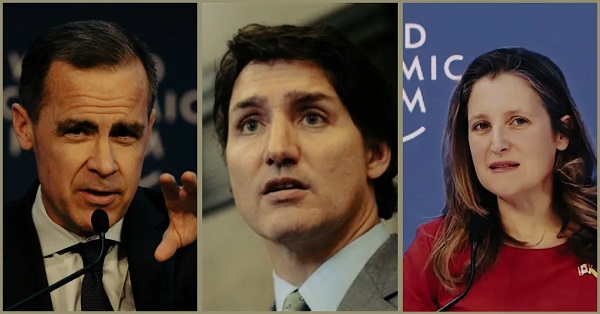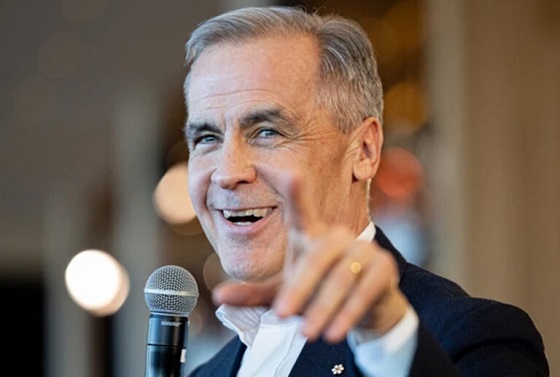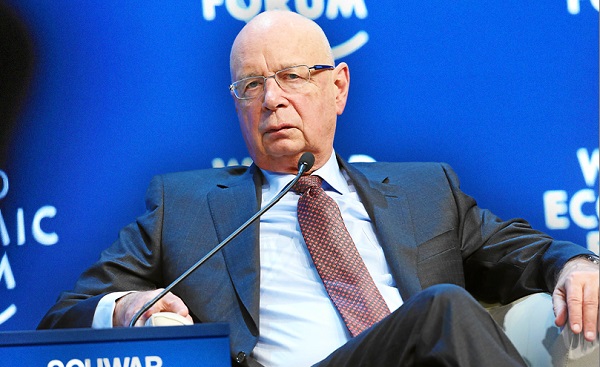Business
StatsCan Confirms Canada’s Middle Class Is Disappearing Under Liberal Mismanagement

A new Statistics Canada report reveals widening income inequality and a shrinking middle class, all while Trudeau’s Liberals push policies that benefit the wealthy and punish working Canadians.
A newly released report from Statistics Canada on household economic accounts for the third quarter of 2024 confirms what many Canadians have long suspected—while the wealthiest continue to rake in profits, middle- and lower-income families are left struggling under the weight of economic policies that seem designed to work against them. The report, released today, paints a stark picture of a country where financial inequality is not just persisting, but growing.
The numbers don’t lie. Income inequality has increased, with the top 40% of earners pulling even further ahead of the bottom 40%. The gap in disposable income between these two groups expanded to 46.9 percentage points, up from 46.3 just a year ago. The highest-income households saw their disposable income rise by 6.8%, largely driven by soaring investment gains, while the poorest Canadians saw only a 3.7% increase, barely enough to keep up with the cost of living. Meanwhile, middle-income earners experienced sluggish wage growth of just 2.7%, well below the national average.
Despite declining interest rates, lower-income households found themselves paying more on mortgages and consumer credit, while the wealthy reaped the benefits of higher investment yields. The data shows that middle-income households, who are already feeling the squeeze from inflation and stagnating wages, saw their share of national income shrink.
The most revealing statistic is in net worth distribution. The top 20% of wealthiest Canadians control nearly two-thirds (64.7%) of the country’s net worth, averaging an eye-watering $3.3 million per household. Meanwhile, the bottom 40% hold just 3.3%, barely scraping by with an average of $83,189 in assets.
However, the real estate market has provided a rare silver lining for some lower-wealth households, as they were able to take advantage of slightly more favorable conditions to buy homes, increasing their net worth at the fastest pace. But even that gain is tempered by the reality that housing costs remain unaffordable for many, and young Canadians under 35 continue to pull back from homeownership altogether.
Let’s be clear—this isn’t happening by accident. This is what happens when you let a government of self-serving narcissists run the country into the ground. Justin Trudeau and his Liberal Party have spent nearly a decade dismantling the Canadian economy, pushing a radical, ideologically driven agenda that benefits their elite donor class while leaving working Canadians behind. And now, as the country crumbles under the weight of their incompetence, Trudeau is running for the exits, leaving the mess to whoever’s foolish enough to take the job.
And what do they do on the way out? Do they work to secure our economy? To make life more affordable? To protect Canadian workers? No. Instead, they decide to pick a fight with the United States. Donald Trump, who actually puts his country first—imagine that—announces a 25% tariff on Canadian imports, a move meant to address drug trafficking and illegal immigration, and what’s the Liberals’ response? Do they try to work out a deal? Do they negotiate in good faith to protect Canadian jobs? No. Instead, Chrystia Freeland comes out swinging, proposing retaliatory tariffs that will hurt Canadian businesses just as much, if not more, than they’ll hurt the U.S.
This isn’t about protecting Canada. This isn’t about securing the border or fighting for our economy. This is about pure, partisan politics. The Liberal base wants conflict with the U.S. Not because it’s good for the country, but because their fragile, self-righteous worldview depends on it. They hate Trump, and they hate that his America-First policies are actually working for American workers. So instead of finding a solution, they escalate. They antagonize. Because their base loves it. Not because Canada benefits, but because Liberals benefit.
Subscribe to The Opposition with Dan Knight .
For the full experience, upgrade your subscription.
And meanwhile, what’s Jagmeet Singh doing? The man who loves to talk about standing up for the working class? He could pull the plug on this corrupt government today with a non-confidence motion. But he won’t. Because, like every other member of the political elite in this country, he’s more interested in protecting his own position than actually doing his job. He makes noise about fighting for Canadian workers, but when the moment comes to act, he folds—again.
So here we are. The economy is in shambles. The wealth gap is growing. The middle class is getting squeezed to death. And the people in charge are too busy playing partisan games to do anything about it. Trudeau is leaving, but his legacy of economic destruction, division, and incompetence will live on through the same out-of-touch Liberal elites who put us in this mess.
But here’s the thing—Canada is better than this. We are a nation built on hard work, freedom, and opportunity, not on government control, reckless spending, and endless excuses. We are a country that thrives when its people—not bureaucrats in Ottawa—decide their own future.
It’s time for Canadians to take their country back. It’s time to put an end to this cycle of economic ruin and government failure. We don’t need more empty promises, more excuses, or more Liberal arrogance. We need an election. We need leaders who believe in the strength of Canadians, not the power of government.
Enough is enough. If we want a future where hard work is rewarded, where families can afford to buy a home, and where our economy is built to benefit all Canadians—not just the elite—then we must act. This country belongs to you, not the Liberal Party, not the special interests, and certainly not the self-serving political class in Ottawa.
Canada deserves better. And the time to demand it is now.
Subscribe to The Opposition with Dan Knight .
For the full experience, upgrade your subscription.
Business
Is Government Inflation Reporting Accurate?


 David Clinton
David Clinton
Who ya gonna believe: official CPI figures or your lyin’ eyes?
Great news! We’ve brought inflation back under control and stuff is now only costing you 2.4 percent more than it did last year!
That’s more or less the message we’ve been hearing from governments over the past couple of years. And in fact, the official Statistics Canada consumer price index (CPI) numbers do show us that the “all-items” index in 2024 was only 2.4 percent higher than in 2023. Fantastic.
So why doesn’t it feel fantastic?
Well statistics are funny that way. When you’ve got lots of numbers, there are all kinds of ways to dress ‘em up before presenting them as an index (or chart). And there really is no one combination of adjustments and corrections that’s definitively “right”. So I’m sure Statistics Canada isn’t trying to misrepresent things.
But I’m also curious to test whether the CPI is truly representative of Canadians’ real financial experiences. My first attempt to create my own alternative “consumer price index”, involved Statistics Canada’s “Detailed household final consumption expenditure”. That table contains actual dollar figures for nation-wide spending on a wide range of consumer items. To represent the costs Canadian’s face when shopping for basics, I selected these nine categories:
- Food and non-alcoholic beverages
- Clothing and footwear
- Housing, water, electricity, gas and other fuels
- Major household appliances
- Pharmaceutical products and other medical products (except cannabis)
- Transport
- Communications
- University education
- Property insurance
I then took the fourth quarter (Q4) numbers for each of those categories for all the years between 2013 and 2024 and divided them by the total population of the country for each year. That gave me an accurate picture of per capita spending on core cost-of-living items.
Overall, living and breathing through Q4 2013 would have cost the average Canadian $4,356.38 (or $17,425.52 for a full year). Spending for those same categories in Q4 2024, however, cost us $6,266.48 – a 43.85 percent increase.
By contrast, the official CPI over those years rose only 31.03 percent. That’s quite the difference. Here’s how the year-over-year changes in CPI inflation vs actual spending inflation compare:
As you can see, with the exception of 2020 (when COVID left us with nothing to buy), the official inflation number was consistently and significantly lower than actual spending. And, in the case of 2021, it was more than double.
Since 2023, the items with the largest price growth were university education (57.46 percent), major household appliances (52.67 percent), and housing, water, electricity, gas, and other fuels (50.79).
Having said all that, you could justifiably argue that the true cost of living hasn’t really gone up that much, but that at least part of the increase in spending is due to a growing taste for luxury items and high volume consumption. I can’t put a precise number on that influence, but I suspect it’s not trivial.
Since data on spending doesn’t seem to be the best measure of inflation, perhaps I could build my own basket of costs and compare those numbers to the official CPI. To do that, I collected average monthly costs for gasoline, home rentals, a selection of 14 core grocery items, and taxes paid by the average Canadian homeowner.¹ I calculated the tax burden (federal, provincial, property, and consumption) using the average of the estimates of two AI models.
How did the inflation represented by my custom basket compare with the official CPI? Well between 2017 and 2024, the Statistics Canada’s CPI grew by 23.39 percent. Over that same time, the monthly cost of my basket grew from $4,514.74 to $5,665.18; a difference of 25.48 percent. That’s not nearly as dramatic a difference as we saw when we measured spending, but it’s not negligible either.
The very fact that the government makes all this data freely available to us is evidence that they’re not out to hide the truth. But it can’t hurt to keep an active and independent eye on them, too.
Subscribe to The Audit.
For the full experience, upgrade your subscription.
2025 Federal Election
Carney’s Hidden Climate Finance Agenda

From Energy Now
By Tammy Nemeth and Ron Wallace
It is high time that Canadians discuss and understand Mark Carney’s avowed plan to re-align capital with global Net Zero goals.
Mark Carney’s economic vision for Canada, one that spans energy, housing and defence, rests on an unspoken, largely undisclosed, linchpin: Climate Finance – one that promises a Net Zero future for Canada but which masks a radical economic overhaul.
Regrettably, Carney’s potential approach to a Net Zero future remains largely unexamined in this election. As the former chair of the Glasgow Financial Alliance for Net Zero (GFANZ), Carney has proposed new policies, offices, agencies, and bureaus required to achieve these goals.. Pieced together from his presentations, discussions, testimonies and book, Carney’s approach to climate finance appears to have four pillars: mandatory climate disclosures, mandatory transition plans, centralized data sharing via the United Nations’ Net Zero Data Public Utility (NZDPU) and compliance with voluntary carbon markets (VCMs). There are serious issues for Canada’s economy if these principles were to form the core values for policies under a potential Liberal government.
About the first pillar Carney has been unequivocal: “Achieving net zero requires a whole economy transition.” This would require a restructuring energy and financial systems to shift away from fossil fuels to renewable energy with Carney insisting repeatedly in his book that “every financial [and business] decision takes climate change into account.” Climate finance, unlike broader sustainable finance with its Environmental, Social, and Governance (ESG) focus would channel capital into sectors aligned with a 2050 Net Zero trajectory. Carney states: “Companies, and those who invest in them…who are part of the solution, will be rewarded. Those lagging behind…will be punished.” In other words, capital would flow to compliant firms but be withheld from so-called “high emitters”.
How will investors, banks and insurers distinguish solution from problem? Mandatory climate disclosures, aligned with the International Sustainability Standards Board (ISSB), would compel firms to report emissions and outline their Net Zero strategies. Canada’s Sustainability Standards Board has adopted these methodologies, despite concerns they would disadvantage Canadian businesses. Here, Carney repeatedly emphasizes disclosures as the cornerstone to track emissions data required to shift capital away from “high emitters”. Without this, he claims, large institutional investors lack the data on supply chains to make informed decisions to shift capital to businesses that are Net Zero compliant.
The second pillar, Mandatory Transition Plans would require companies to map a 2050 Net Zero trajectory for emission reduction targets. Failure to meet those targets would invite pressure from investors, banks, or activists, who may pursue litigation for non-compliance. The UK’s Transition Plan Task Force, now part of ISSB, provides this standardized framework. Carney, while at GFANZ, advocated using transition plans for a “managed phase-out” of high-emitting assets like coal, oil and gas, not just through divestment but by financing emissions reductions. “As part of their transition planning, [GFANZ] members should establish and apply financing policies to phase out and align carbon-intensive sectors and activities, such as thermal coal, oil and gas and deforestation, not only through asset divestment but also through transition finance that reduces real world emissions. To assist with these efforts GFANZ will continue to develop and implement a framework for the Managed Phase-out of high-emitting assets.” Clearly, the purpose of this is to ensure companies either decarbonize or face capital withdrawal.
The third pillar is the United Nations’ Net Zero Data Public Utility (NZDPU), a centralized platform for emissions and transition data. Carney insists these data be freely accessible, enabling investors, banks and insurers to judge companies’ progress to Net Zero. As Carney noted in 2021: “Private finance is judging…banks, pension funds and asset managers have to show where they are in the transition to Net Zero.” Hence, compliant firms would receive investment; laggards would face divestment.
Finally, voluntary carbon markets (VCMs) allow companies to offset emissions by purchasing credits from projects like reforestation. Carney, who launched the Taskforce on Scaling VCMs in 2020, has insisted on monitoring, verification and lifecycle tracking. At a 2024 Beijing conference, he suggested major jurisdictions could establish VCMs by COP 30 (planned for 2025 in Brazil) to create a global market. If Canada mandates VCMs, businesses especially small and medium enterprises (SMEs) would face much higher compliance costs with credits available only to those that demonstrate progress with transition plans.
These potential mandatory disclosures and transition plans would burden Canadian businesses with material costs and legal risks that constitute an economic gamble which few may recognize but all should weigh. Do Canadians truly want a government that has an undisclosed climate finance agenda that would be subservient to an opaque globalized Net Zero agenda?
Tammy Nemeth is a U.K.-based strategic energy analyst. Ron Wallace is an executive fellow of the Canadian Global Affairs Institute and the Canada West Foundation.
-

 2025 Federal Election2 days ago
2025 Federal Election2 days agoBREAKING: THE FEDERAL BRIEF THAT SHOULD SINK CARNEY
-

 Media2 days ago
Media2 days agoCBC retracts false claims about residential schools after accusing Rebel News of ‘misinformation’
-

 Business2 days ago
Business2 days ago‘Great Reset’ champion Klaus Schwab resigns from WEF
-

 Bjorn Lomborg2 days ago
Bjorn Lomborg2 days agoNet zero’s cost-benefit ratio is CRAZY high
-

 Business1 day ago
Business1 day agoTrump: China’s tariffs to “come down substantially” after negotiations with Xi
-

 International2 days ago
International2 days agoPope Francis’ funeral to take place Saturday
-

 Business2 days ago
Business2 days agoHudson’s Bay Bid Raises Red Flags Over Foreign Influence
-

 Business24 hours ago
Business24 hours agoTrump considers $5K bonus for moms to increase birthrate








